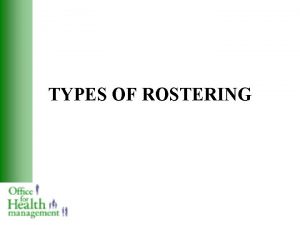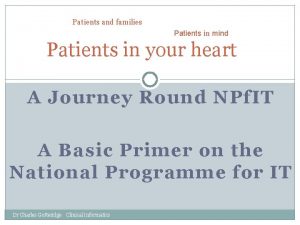TYPES OF ROSTERING Realities of Rostering Patients need














- Slides: 14

TYPES OF ROSTERING

Realities of Rostering • • • Patients need care at all hours It’s not new - in history lies controversy Regulations & contracts exist People have personal lives People attach values to their working schedules • The calendar is awkward • Done well, it takes time, energy & skills

Centralised Rostering Rosters are prepared in the Nursing Office or other central place, usually for more than one ward or work area. Rosters are usually approved by the Matron, Director of Nursing or another senior nurse.

Ward-Based Rostering Rosters are prepared and approved on each ward by the ward manager (usually a CNM 2)

Fixed Rosters A rostering method characterised by a pre -planned roster that repeats itself at regular intervals. Staff usually have a fixed pattern of work and so know for months in advance when they will be working.

Variable Rostering A pattern of rostering that is newlycreated each time-period. Rosters may be changed at short notice to accommodate absences.

Combination Rostering A rostering system where some staff have fixed work patterns and others are “filled-in” around them.

Manual Rostering Central or ward-based rostering which is done manually and without the aid of a computer software package

Electronic Rostering The use of specialised rostering computer software packages to generate rosters. The ward manager then verifies the roster and makes any changes. This is not the same as using a computer to type -up a roster or using a “time & attendance” or payroll system to record hours worked.

Team-Based Self-Rostering Rosters are prepared by staff using agreed staffing guidelines and staff mix. Staff negotiate with each other and agree work schedules and ward cover. The ward manager does not normally participate in rostering except when cover cannot be obtained from the current staff.

Centralised Rostering (Suits highly stable situations) Advantages: • Gives a “big picture” view • Allows ward staff to focus on care • Roster scheduler becomes very efficient • Senior nurse management is accountable Disadvantages: • Staff have little real say • Can be remote from ward needs • Staff and CNMs are not accountable

Ward-Based Rostering (Requires co-ordination with some central source) Advantages: • Scheduler knows the ward & staff • Staff can be more involved • CNM can control staffing - important for financial accountability Disadvantages: • Takes time away from patient care • CNM may experience pressure from staff • Ward schedulers may not be as skilled or experienced as in centralised rostering

Team-Based Self-Rostering Advantages • Staff control the process • Staff become more accountable • Maximises flexibility • Good way to build cooperation, negotiation & teamwork Disadvantages • Requires managers to delegate and trust staff • Managers still have ultimate accountability • Requires preparation and development of staff

Electronic Rostering • Fundamentally the same as manual rostering • Requires computer access & skills • Does not replace the need for human scrutiny • Streamlines record-keeping, payroll & benefits • Provides data for planning
 Rostering patients
Rostering patients Quintiq rostering
Quintiq rostering Care and custody rostering
Care and custody rostering Electronic rostering
Electronic rostering What is lateral position in nursing
What is lateral position in nursing Introduction of lifting and transferring of patients
Introduction of lifting and transferring of patients 7 realities of experiencing god diagram
7 realities of experiencing god diagram What forces are defining the new marketing realities?
What forces are defining the new marketing realities? Human person and values development
Human person and values development International business chapter 2
International business chapter 2 The actual and potential rival offerings
The actual and potential rival offerings 7 realities for experiencing god
7 realities for experiencing god Target needs analysis
Target needs analysis Life expectancy of sickle cell patients
Life expectancy of sickle cell patients Perimylolysis
Perimylolysis

























